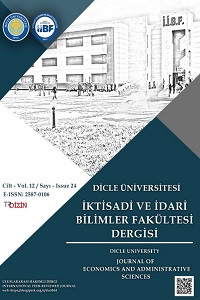Öz
Bu çalışma, temelde üretim sürecinde kullanılan emek girdisi artırılarak dış borç alma gereksiniminin bir dereceye kadar azaltılabileceği varsayımına dayanmaktadır. Çalışmada, CES üretim fonksiyonu ve translog üretim fonksiyonunu kullanılarak sermaye, emek ve enerji tüketimi girdi faktörleri ile gelişmekte olan 22 ülke için ekonomik girdi faktörlerinin ekonomik büyüme üzerindeki etkisini araştırmak amaçlanmıştır. Çalışmada analiz için 1980-2016 dönemine ait veri seti kullanılmıştır. Translog üretim fonksiyonuna ait parametrelerin kestirimi için Ridge regresyon yöntemi, CES üretim fonksiyonuna ait parametrelerin kestirimi için ise doğrusal olmayan optimizasyon tekniklerinden faydalanılmıştır. Yapılan analizler sonucunda, gelişmekte olan ülkelerdeki yetersiz sermaye birikiminin dış borç kullanılarak telafi edilmesinin doğru olmayacağı söylenebilir. Bu bağlamda, gelişmiş ülkelere ait üretim fonksiyonunda yer alan sermaye – emek – enerji tüketimi gereksinimlerinin gelişmekte olan ülkelerde farklı ağırlıklarda düşünülebilir. Böylece, dış borç alma gereksinimi azaltılabilir.
Anahtar Kelimeler
Üretim fonksiyonu panel veri analizi ekonomik büyüme gelişmekte olan ülkeler.
Kaynakça
- Arrow, K. J., Chenery, H. B., Minhas, B. S., & Solow, R. M. (1961). Capital-Labor Substitution and Economic Efficiency. The Review of Economics and Statistics, 43(3), 225–250. https://doi.org/10.2307/1927286
- Barro, R. J., & Lee, J. W. (2013). A New Data Set of Educational Attainment in the World, 1950-2010. Journal of Development Economics, 104, 184–198.
- Besanko, D. A., & Braeutigam, R. R. (2010). Microeconomics (4 th.). John Wiley & Sons, Inc.
- Büyükuysal, M. Ç., & Öz, İ. İ. (2016). Çoklu Doğrusal Bağıntı Varlığında En Küçük Karelere Alternatif Yaklaşım: Ridge Regresyon. Düzce Üniversitesi Sağlık Bilimleri Enstitüsü Dergisi, 6(2), 110–114.
- Cheng, M., & Han, Y. (2017). Application of a New Superposition CES Production Function Model. Journal of Systems Science and Information, 5(5), 462–472. https://doi.org/10.21078/JSSI-2017-462-11
- Christensen, L. R., Jorgenson, D. W., & Lau, L. J. (1973). Transcendental Logarithmic Production Frontiers. The Review of Economics and Statistics, 55(1), 28–45. https://www.jstor.org/stable/pdf/1927992
- Cohen, D., & Soto, M. (2007). Growth and Human Capital: Good Data, Good Results. J Econ Growth, 12, 51–76. https://doi.org/10.1007/s10887-007-9011-5
- Eğilmez, M. (2016). Mikroekonomi: Güncel Örneklerle (2nd ed.). Remzi Kitapevi.
- Henningsen, A., & Henningsen, G. (2012). On Estimation of The CES Production Function-Revisited. Economics Letters, 115(1), 67–69. https://doi.org/10.1016/j.econlet.2011.12.007
- Henningsen, A., Henningsen, G., & Van Der Werf, E. (2019). Capital-Labour-Energy Substitution in a Nested CES Framework: A Replication and Update of Kemfert (1998). Energy Economics, 82, 16–25. https://doi.org/10.1016/j.eneco.2017.12.019
- Henningsen, G., & Henningsen, A. (2011). Econometric Estimation of the “Constant Elasticity of Substitution” Function in R: Package micEconCES (FOI Working Paper 2011 / 9). Frederiksberg: Institute of Food and Resource Economics.
- Hoerl, A. E., & Kennard, R. W. (1970). Ridge Regression: Biased Estimation for Nonorthogonal Problems. Technometrics, 12(1), 55–67. https://doi.org/10.1080/00401706.1970.10488634
- Hoff, A. (2002). The translog approximation of the constant elasticity of substitution production function with more than two input variables (Issue 14). Fødevareøkonomisk Institut. http://curis.ku.dk/ws/files/135535225/14.pdf.pdf
- Kadiyala, K. (1984). A Class of Almost Unbiased and Efficient Estimators of Regression Coefficients. Economics Letters, 16(3–4), 293–296. https://doi.org/10.1016/0165-1765(84)90178-2
- Kemfert, C. (1998). Estimated substitution of a nested CES production function approach for Germany. Energy Economics, 20, 249–264.
- Kmenta, J. (1967). On Estimation of the CES Production Function. International Economic Review, 8(2), 180–189.
- Lin, B., & Ahmad, I. (2016). Energy substitution effect on transport sector of Pakistan based on trans-log production function. Renewable and Sustainable Energy Reviews, 56, 1182–1193. https://doi.org/10.1016/j.rser.2015.12.012
- Lin, B., & Liu, W. (2017). Estimation of energy substitution effect in China’s machinery industry–based on the corrected formula for elasticity of substitution. Energy, 129, 246–254. https://doi.org/10.1016/j.energy.2017.04.103
- Lloyd, P. J., & MacLaren, D. (2002). Measures of trade openness using CGE analysis. Journal of Policy Modeling, 24(1), 67–81. https://doi.org/10.1016/S0161-8938(01)00096-5
- McDonald, G. C. (2009). Ridge regression. Wiley Interdisciplinary Reviews: Computational Statistics, 1(1), 93–100. https://doi.org/10.1002/wics.14
- McFadden, D. (1963). Constant elasticity of substitution production functions. The Review of Economic Studies, 30(2), 73–83. https://www.jstor.org/stable/2295804
- McFarland, J. R., Reilly, J. M., & Herzog, H. J. (2004). Representing energy technologies in top-down economic models using bottom-up information. Energy Economics, 26(4), 685–707. https://doi.org/10.1016/j.eneco.2004.04.026
- NCSS Statistical Software. (2019). Ridge Regression (pp. 1–21). NCSS.com.
- Papageorgiou, C., & Saam, M. (2008). Two-level CES production technology in the solow and diamond growth models. Scandinavian Journal of Economics, 110(1), 119–143. https://doi.org/10.1111/j.1467-9442.2008.00529.x
- Piketty, T. (2014). Yirmi Birinci Yüzyılda Kapital (Çeviren: Hande Koçak) (2. baskı). Türkiye İş Bankası Kültür Yayınları.
- Sato, K. (1967). A Two-Level Constant-Elasticity-of-Substitution Production Function. Source: The Review of Economic Studies, 34(2), 201–218. https://www.jstor.org/stable/pdf/2296809.pdf
- Singh, B., Chaubey, Y. P., & Dwivedi, T. D. (1986). An Almost Unbiased Ridge Estimator. Indian Statistical Institute, 48(3), 342–346. https://about.jstor.org/terms
- Songur, M. (2019). Gelişmiş ve Gelişmekte Olan Ülkelerde Emek-Sermaye-Enerji Faktörlerinin İkame Esnekliği ve Çıktı Esneklikleri. Ankara Hacı Bayram Veli Üniversitesi İktisadi ve İdari Bilimler Fakültesi Dergisi, 21(3), 757–784.
- Taşdemir, M. (2006). Üretim Fonksiyonu Tahminlerinde Karşılaşılan Problemler ve Eşanlı Denklem Sapması: Alternatif Tahmin Yöntemleri. Doğu Anadolu Bölgesi Araştırmaları, 23–31.
- The MSCI Emerging Market Index. (2020). https://www.msci.com/market-cap-weighted-indexes Uzawa, H. (1962). Production Functions with Constant Elasticities of Substitution. The Review of Economic Studies, 29(4), 291. https://doi.org/10.2307/2296305
- Vinod, H. D., & Ullah, A. (1981). Recent Advances in Regression Methods. In Marcel Dekker Incorporated.
- Wesseh, P. K., & Lin, B. (2016). Output and Substitution Elasticities of Energy and Implications for Renewable Energy Expansion in the ECOWAS Region. Energy Policy, 89, 125–137. https://doi.org/10.1016/j.enpol.2015.11.007
Ayrıntılar
| Birincil Dil | Türkçe |
|---|---|
| Konular | Ekonomi |
| Bölüm | Araştırma Makalesi |
| Yazarlar | |
| Yayımlanma Tarihi | 28 Kasım 2022 |
| Gönderilme Tarihi | 13 Haziran 2022 |
| Kabul Tarihi | 31 Ekim 2022 |
| Yayımlandığı Sayı | Yıl 2022 Cilt: 12 Sayı: 24 |
Kaynak Göster
Bu dergide yayınlanan tüm çalışmalar, Creative Commons Attribution-NonCommercial 4.0 International (CC BY-NC 4.0) License kapsamında lisanslanmıştır.


